University of Westminster: Social Media in Retail Sector Analysis
VerifiedAdded on 2022/12/01
|19
|5350
|469
Report
AI Summary
This report examines the profound impact of social media on the retail industry, focusing on how platforms like Facebook and Instagram have reshaped business strategies. It analyzes the practices of major players such as Walmart, Tesco, and ASAD, exploring the shift from traditional advertising to social media-driven marketing. The report covers key aspects like business drivers, the role of social media in customer engagement, and its influence on purchasing decisions. It delves into the evolution of social media's role from information provider to influencer, highlighting its impact on sales, brand perception, and customer education. The study also explores the integration of social media with online retail and its effect on FMCG. Ultimately, the report provides recommendations for organizations to effectively leverage social media to improve business performance and adapt to the changing landscape of the retail sector.

1
Paraphrase This Document
Need a fresh take? Get an instant paraphrase of this document with our AI Paraphraser
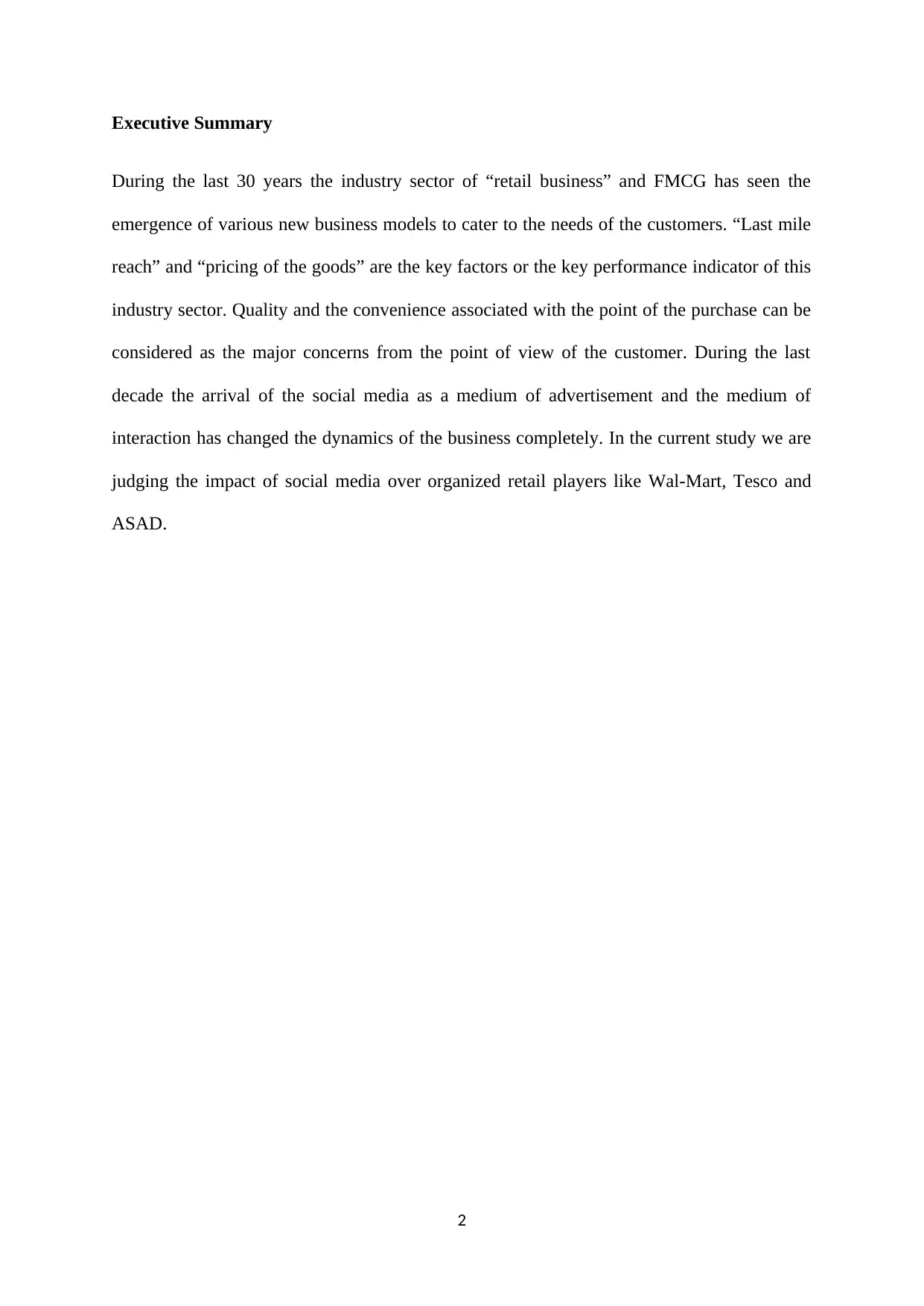
Executive Summary
During the last 30 years the industry sector of “retail business” and FMCG has seen the
emergence of various new business models to cater to the needs of the customers. “Last mile
reach” and “pricing of the goods” are the key factors or the key performance indicator of this
industry sector. Quality and the convenience associated with the point of the purchase can be
considered as the major concerns from the point of view of the customer. During the last
decade the arrival of the social media as a medium of advertisement and the medium of
interaction has changed the dynamics of the business completely. In the current study we are
judging the impact of social media over organized retail players like Wal-Mart, Tesco and
ASAD.
2
During the last 30 years the industry sector of “retail business” and FMCG has seen the
emergence of various new business models to cater to the needs of the customers. “Last mile
reach” and “pricing of the goods” are the key factors or the key performance indicator of this
industry sector. Quality and the convenience associated with the point of the purchase can be
considered as the major concerns from the point of view of the customer. During the last
decade the arrival of the social media as a medium of advertisement and the medium of
interaction has changed the dynamics of the business completely. In the current study we are
judging the impact of social media over organized retail players like Wal-Mart, Tesco and
ASAD.
2

Table of Content
Introduction……………………………………………………………………………….4
Literature Review…………………………………………………………………………9
Business drivers…………………………………………………………………………...11
Recommendations…………………………………………………………………………13
3
Introduction……………………………………………………………………………….4
Literature Review…………………………………………………………………………9
Business drivers…………………………………………………………………………...11
Recommendations…………………………………………………………………………13
3
⊘ This is a preview!⊘
Do you want full access?
Subscribe today to unlock all pages.

Trusted by 1+ million students worldwide
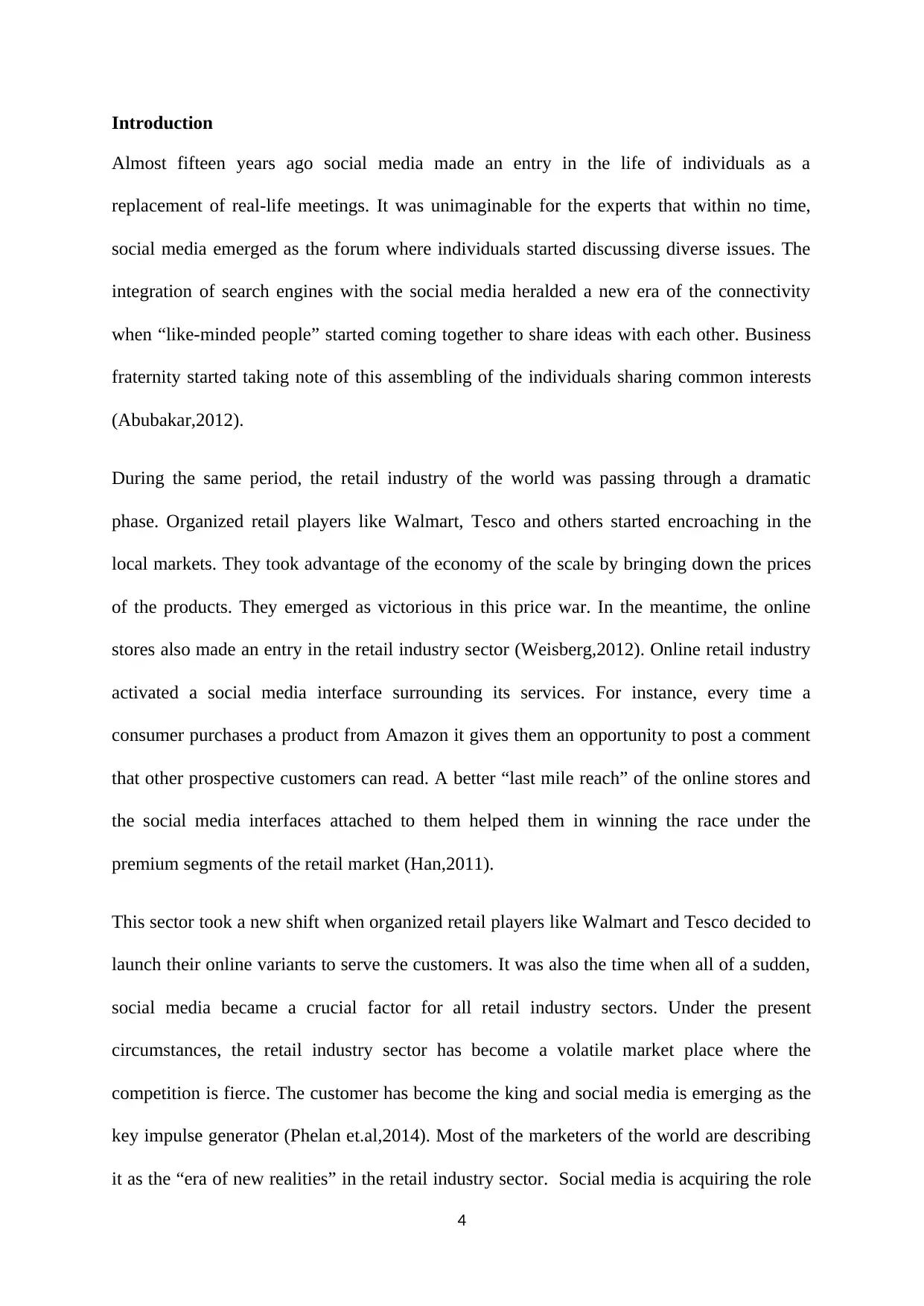
Introduction
Almost fifteen years ago social media made an entry in the life of individuals as a
replacement of real-life meetings. It was unimaginable for the experts that within no time,
social media emerged as the forum where individuals started discussing diverse issues. The
integration of search engines with the social media heralded a new era of the connectivity
when “like-minded people” started coming together to share ideas with each other. Business
fraternity started taking note of this assembling of the individuals sharing common interests
(Abubakar,2012).
During the same period, the retail industry of the world was passing through a dramatic
phase. Organized retail players like Walmart, Tesco and others started encroaching in the
local markets. They took advantage of the economy of the scale by bringing down the prices
of the products. They emerged as victorious in this price war. In the meantime, the online
stores also made an entry in the retail industry sector (Weisberg,2012). Online retail industry
activated a social media interface surrounding its services. For instance, every time a
consumer purchases a product from Amazon it gives them an opportunity to post a comment
that other prospective customers can read. A better “last mile reach” of the online stores and
the social media interfaces attached to them helped them in winning the race under the
premium segments of the retail market (Han,2011).
This sector took a new shift when organized retail players like Walmart and Tesco decided to
launch their online variants to serve the customers. It was also the time when all of a sudden,
social media became a crucial factor for all retail industry sectors. Under the present
circumstances, the retail industry sector has become a volatile market place where the
competition is fierce. The customer has become the king and social media is emerging as the
key impulse generator (Phelan et.al,2014). Most of the marketers of the world are describing
it as the “era of new realities” in the retail industry sector. Social media is acquiring the role
4
Almost fifteen years ago social media made an entry in the life of individuals as a
replacement of real-life meetings. It was unimaginable for the experts that within no time,
social media emerged as the forum where individuals started discussing diverse issues. The
integration of search engines with the social media heralded a new era of the connectivity
when “like-minded people” started coming together to share ideas with each other. Business
fraternity started taking note of this assembling of the individuals sharing common interests
(Abubakar,2012).
During the same period, the retail industry of the world was passing through a dramatic
phase. Organized retail players like Walmart, Tesco and others started encroaching in the
local markets. They took advantage of the economy of the scale by bringing down the prices
of the products. They emerged as victorious in this price war. In the meantime, the online
stores also made an entry in the retail industry sector (Weisberg,2012). Online retail industry
activated a social media interface surrounding its services. For instance, every time a
consumer purchases a product from Amazon it gives them an opportunity to post a comment
that other prospective customers can read. A better “last mile reach” of the online stores and
the social media interfaces attached to them helped them in winning the race under the
premium segments of the retail market (Han,2011).
This sector took a new shift when organized retail players like Walmart and Tesco decided to
launch their online variants to serve the customers. It was also the time when all of a sudden,
social media became a crucial factor for all retail industry sectors. Under the present
circumstances, the retail industry sector has become a volatile market place where the
competition is fierce. The customer has become the king and social media is emerging as the
key impulse generator (Phelan et.al,2014). Most of the marketers of the world are describing
it as the “era of new realities” in the retail industry sector. Social media is acquiring the role
4
Paraphrase This Document
Need a fresh take? Get an instant paraphrase of this document with our AI Paraphraser
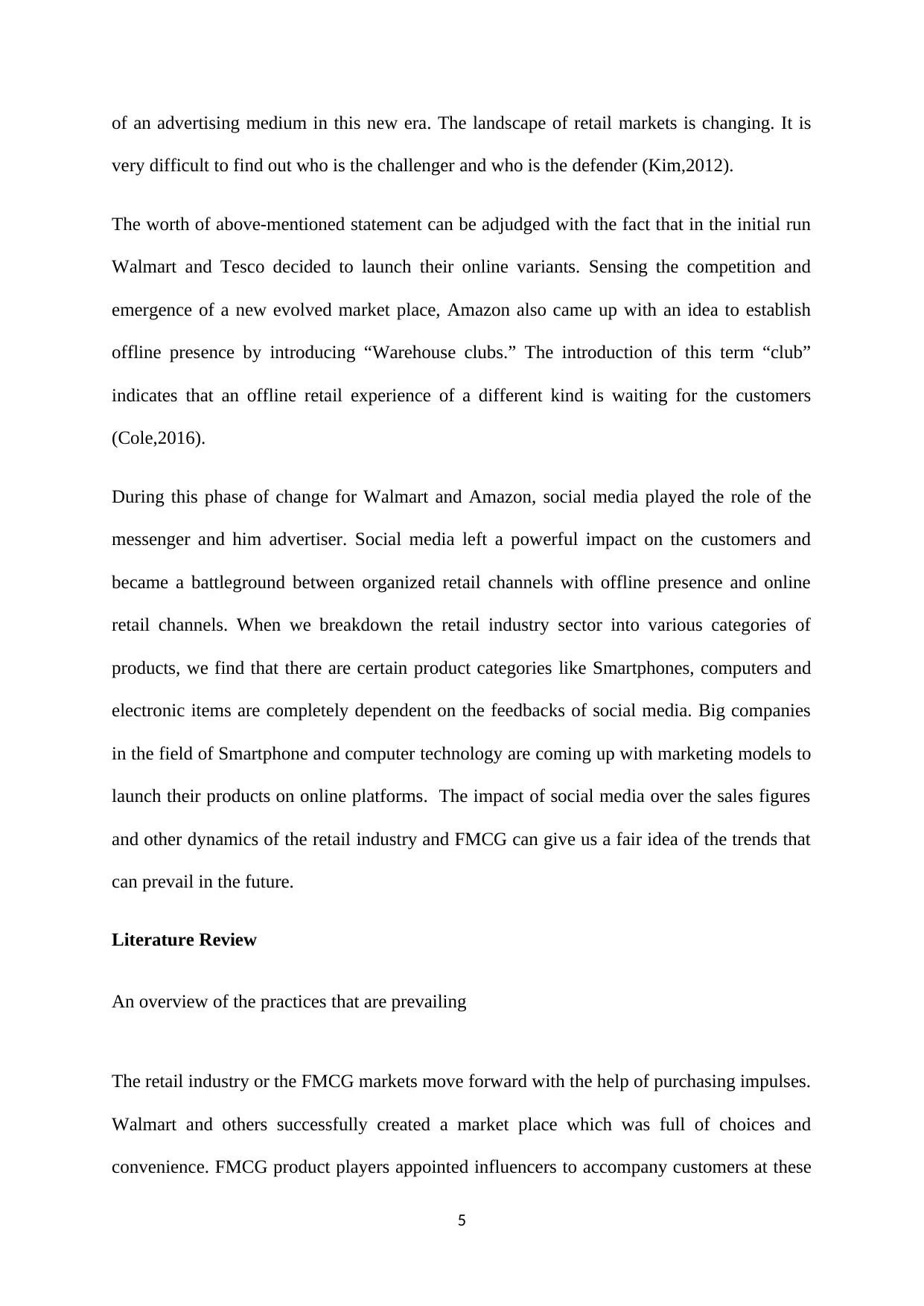
of an advertising medium in this new era. The landscape of retail markets is changing. It is
very difficult to find out who is the challenger and who is the defender (Kim,2012).
The worth of above-mentioned statement can be adjudged with the fact that in the initial run
Walmart and Tesco decided to launch their online variants. Sensing the competition and
emergence of a new evolved market place, Amazon also came up with an idea to establish
offline presence by introducing “Warehouse clubs.” The introduction of this term “club”
indicates that an offline retail experience of a different kind is waiting for the customers
(Cole,2016).
During this phase of change for Walmart and Amazon, social media played the role of the
messenger and him advertiser. Social media left a powerful impact on the customers and
became a battleground between organized retail channels with offline presence and online
retail channels. When we breakdown the retail industry sector into various categories of
products, we find that there are certain product categories like Smartphones, computers and
electronic items are completely dependent on the feedbacks of social media. Big companies
in the field of Smartphone and computer technology are coming up with marketing models to
launch their products on online platforms. The impact of social media over the sales figures
and other dynamics of the retail industry and FMCG can give us a fair idea of the trends that
can prevail in the future.
Literature Review
An overview of the practices that are prevailing
The retail industry or the FMCG markets move forward with the help of purchasing impulses.
Walmart and others successfully created a market place which was full of choices and
convenience. FMCG product players appointed influencers to accompany customers at these
5
very difficult to find out who is the challenger and who is the defender (Kim,2012).
The worth of above-mentioned statement can be adjudged with the fact that in the initial run
Walmart and Tesco decided to launch their online variants. Sensing the competition and
emergence of a new evolved market place, Amazon also came up with an idea to establish
offline presence by introducing “Warehouse clubs.” The introduction of this term “club”
indicates that an offline retail experience of a different kind is waiting for the customers
(Cole,2016).
During this phase of change for Walmart and Amazon, social media played the role of the
messenger and him advertiser. Social media left a powerful impact on the customers and
became a battleground between organized retail channels with offline presence and online
retail channels. When we breakdown the retail industry sector into various categories of
products, we find that there are certain product categories like Smartphones, computers and
electronic items are completely dependent on the feedbacks of social media. Big companies
in the field of Smartphone and computer technology are coming up with marketing models to
launch their products on online platforms. The impact of social media over the sales figures
and other dynamics of the retail industry and FMCG can give us a fair idea of the trends that
can prevail in the future.
Literature Review
An overview of the practices that are prevailing
The retail industry or the FMCG markets move forward with the help of purchasing impulses.
Walmart and others successfully created a market place which was full of choices and
convenience. FMCG product players appointed influencers to accompany customers at these
5
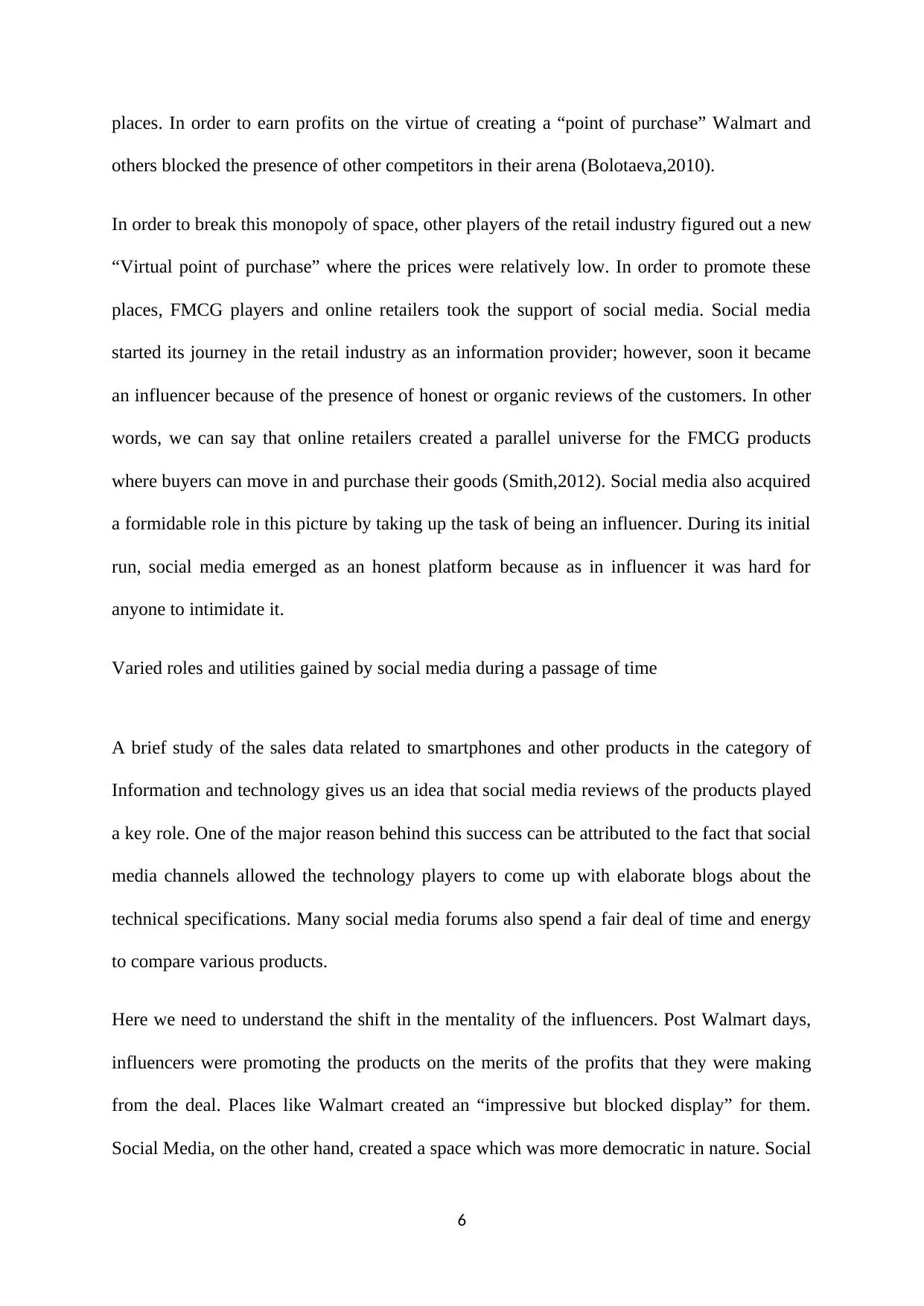
places. In order to earn profits on the virtue of creating a “point of purchase” Walmart and
others blocked the presence of other competitors in their arena (Bolotaeva,2010).
In order to break this monopoly of space, other players of the retail industry figured out a new
“Virtual point of purchase” where the prices were relatively low. In order to promote these
places, FMCG players and online retailers took the support of social media. Social media
started its journey in the retail industry as an information provider; however, soon it became
an influencer because of the presence of honest or organic reviews of the customers. In other
words, we can say that online retailers created a parallel universe for the FMCG products
where buyers can move in and purchase their goods (Smith,2012). Social media also acquired
a formidable role in this picture by taking up the task of being an influencer. During its initial
run, social media emerged as an honest platform because as in influencer it was hard for
anyone to intimidate it.
Varied roles and utilities gained by social media during a passage of time
A brief study of the sales data related to smartphones and other products in the category of
Information and technology gives us an idea that social media reviews of the products played
a key role. One of the major reason behind this success can be attributed to the fact that social
media channels allowed the technology players to come up with elaborate blogs about the
technical specifications. Many social media forums also spend a fair deal of time and energy
to compare various products.
Here we need to understand the shift in the mentality of the influencers. Post Walmart days,
influencers were promoting the products on the merits of the profits that they were making
from the deal. Places like Walmart created an “impressive but blocked display” for them.
Social Media, on the other hand, created a space which was more democratic in nature. Social
6
others blocked the presence of other competitors in their arena (Bolotaeva,2010).
In order to break this monopoly of space, other players of the retail industry figured out a new
“Virtual point of purchase” where the prices were relatively low. In order to promote these
places, FMCG players and online retailers took the support of social media. Social media
started its journey in the retail industry as an information provider; however, soon it became
an influencer because of the presence of honest or organic reviews of the customers. In other
words, we can say that online retailers created a parallel universe for the FMCG products
where buyers can move in and purchase their goods (Smith,2012). Social media also acquired
a formidable role in this picture by taking up the task of being an influencer. During its initial
run, social media emerged as an honest platform because as in influencer it was hard for
anyone to intimidate it.
Varied roles and utilities gained by social media during a passage of time
A brief study of the sales data related to smartphones and other products in the category of
Information and technology gives us an idea that social media reviews of the products played
a key role. One of the major reason behind this success can be attributed to the fact that social
media channels allowed the technology players to come up with elaborate blogs about the
technical specifications. Many social media forums also spend a fair deal of time and energy
to compare various products.
Here we need to understand the shift in the mentality of the influencers. Post Walmart days,
influencers were promoting the products on the merits of the profits that they were making
from the deal. Places like Walmart created an “impressive but blocked display” for them.
Social Media, on the other hand, created a space which was more democratic in nature. Social
6
⊘ This is a preview!⊘
Do you want full access?
Subscribe today to unlock all pages.

Trusted by 1+ million students worldwide
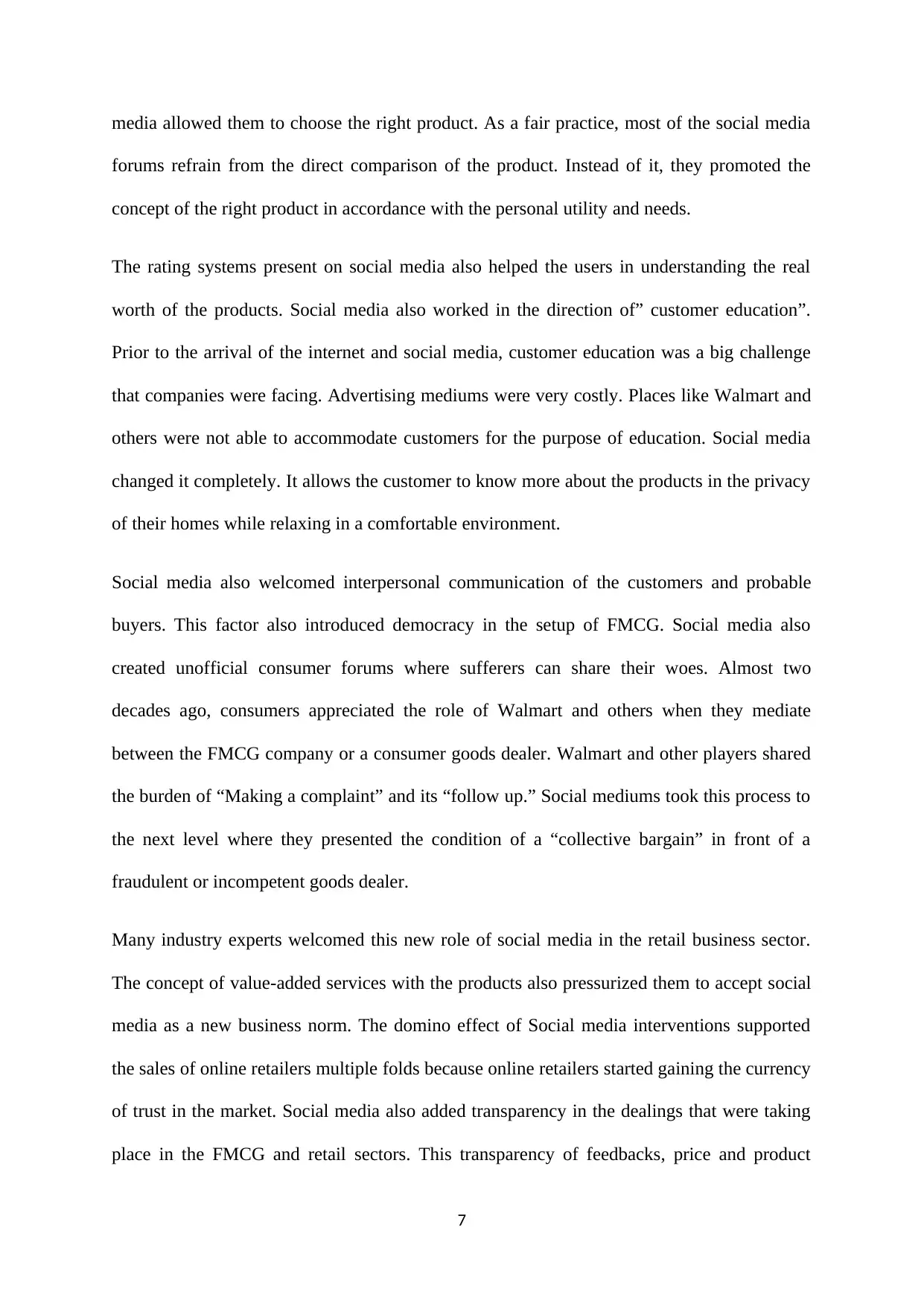
media allowed them to choose the right product. As a fair practice, most of the social media
forums refrain from the direct comparison of the product. Instead of it, they promoted the
concept of the right product in accordance with the personal utility and needs.
The rating systems present on social media also helped the users in understanding the real
worth of the products. Social media also worked in the direction of” customer education”.
Prior to the arrival of the internet and social media, customer education was a big challenge
that companies were facing. Advertising mediums were very costly. Places like Walmart and
others were not able to accommodate customers for the purpose of education. Social media
changed it completely. It allows the customer to know more about the products in the privacy
of their homes while relaxing in a comfortable environment.
Social media also welcomed interpersonal communication of the customers and probable
buyers. This factor also introduced democracy in the setup of FMCG. Social media also
created unofficial consumer forums where sufferers can share their woes. Almost two
decades ago, consumers appreciated the role of Walmart and others when they mediate
between the FMCG company or a consumer goods dealer. Walmart and other players shared
the burden of “Making a complaint” and its “follow up.” Social mediums took this process to
the next level where they presented the condition of a “collective bargain” in front of a
fraudulent or incompetent goods dealer.
Many industry experts welcomed this new role of social media in the retail business sector.
The concept of value-added services with the products also pressurized them to accept social
media as a new business norm. The domino effect of Social media interventions supported
the sales of online retailers multiple folds because online retailers started gaining the currency
of trust in the market. Social media also added transparency in the dealings that were taking
place in the FMCG and retail sectors. This transparency of feedbacks, price and product
7
forums refrain from the direct comparison of the product. Instead of it, they promoted the
concept of the right product in accordance with the personal utility and needs.
The rating systems present on social media also helped the users in understanding the real
worth of the products. Social media also worked in the direction of” customer education”.
Prior to the arrival of the internet and social media, customer education was a big challenge
that companies were facing. Advertising mediums were very costly. Places like Walmart and
others were not able to accommodate customers for the purpose of education. Social media
changed it completely. It allows the customer to know more about the products in the privacy
of their homes while relaxing in a comfortable environment.
Social media also welcomed interpersonal communication of the customers and probable
buyers. This factor also introduced democracy in the setup of FMCG. Social media also
created unofficial consumer forums where sufferers can share their woes. Almost two
decades ago, consumers appreciated the role of Walmart and others when they mediate
between the FMCG company or a consumer goods dealer. Walmart and other players shared
the burden of “Making a complaint” and its “follow up.” Social mediums took this process to
the next level where they presented the condition of a “collective bargain” in front of a
fraudulent or incompetent goods dealer.
Many industry experts welcomed this new role of social media in the retail business sector.
The concept of value-added services with the products also pressurized them to accept social
media as a new business norm. The domino effect of Social media interventions supported
the sales of online retailers multiple folds because online retailers started gaining the currency
of trust in the market. Social media also added transparency in the dealings that were taking
place in the FMCG and retail sectors. This transparency of feedbacks, price and product
7
Paraphrase This Document
Need a fresh take? Get an instant paraphrase of this document with our AI Paraphraser
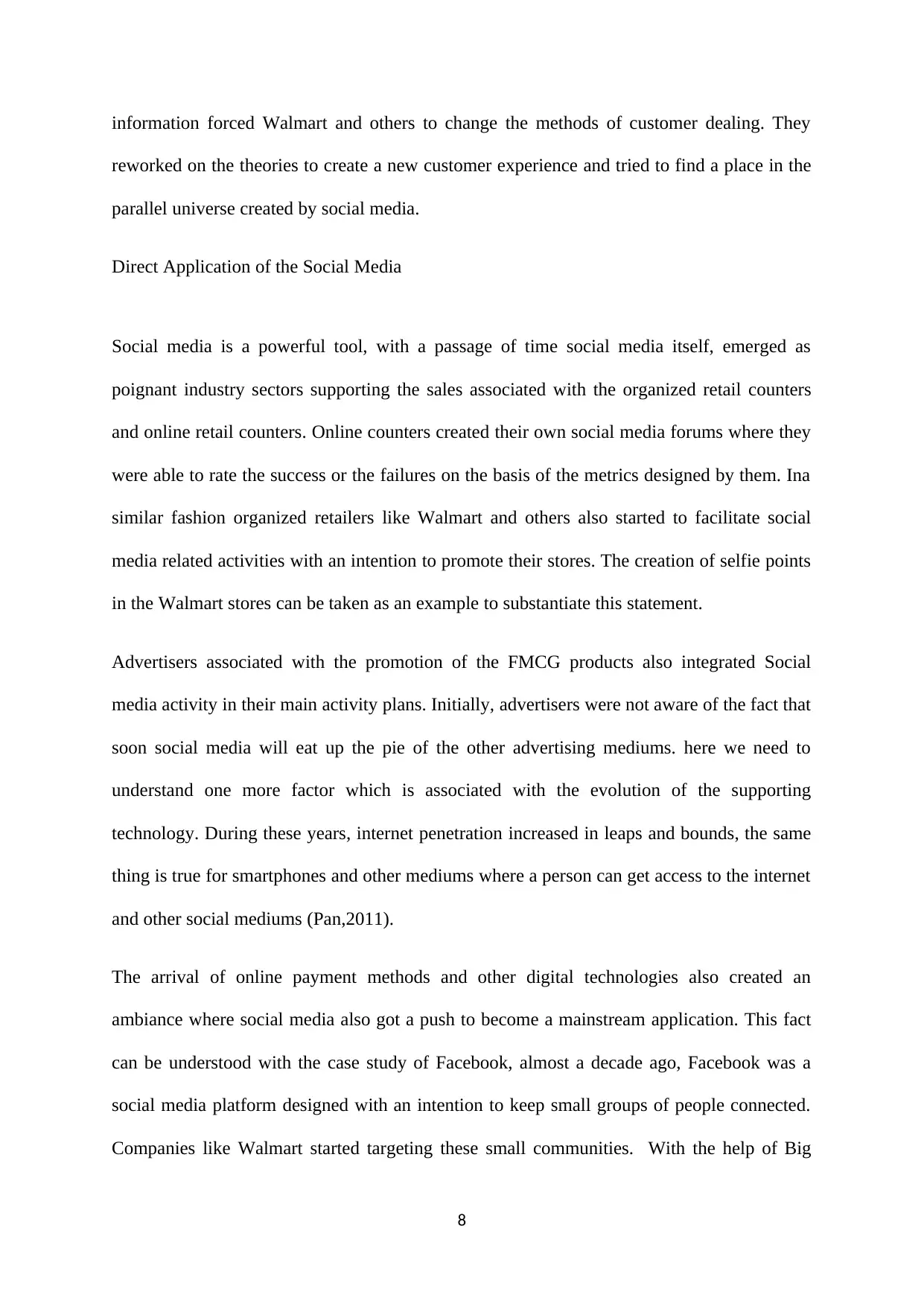
information forced Walmart and others to change the methods of customer dealing. They
reworked on the theories to create a new customer experience and tried to find a place in the
parallel universe created by social media.
Direct Application of the Social Media
Social media is a powerful tool, with a passage of time social media itself, emerged as
poignant industry sectors supporting the sales associated with the organized retail counters
and online retail counters. Online counters created their own social media forums where they
were able to rate the success or the failures on the basis of the metrics designed by them. Ina
similar fashion organized retailers like Walmart and others also started to facilitate social
media related activities with an intention to promote their stores. The creation of selfie points
in the Walmart stores can be taken as an example to substantiate this statement.
Advertisers associated with the promotion of the FMCG products also integrated Social
media activity in their main activity plans. Initially, advertisers were not aware of the fact that
soon social media will eat up the pie of the other advertising mediums. here we need to
understand one more factor which is associated with the evolution of the supporting
technology. During these years, internet penetration increased in leaps and bounds, the same
thing is true for smartphones and other mediums where a person can get access to the internet
and other social mediums (Pan,2011).
The arrival of online payment methods and other digital technologies also created an
ambiance where social media also got a push to become a mainstream application. This fact
can be understood with the case study of Facebook, almost a decade ago, Facebook was a
social media platform designed with an intention to keep small groups of people connected.
Companies like Walmart started targeting these small communities. With the help of Big
8
reworked on the theories to create a new customer experience and tried to find a place in the
parallel universe created by social media.
Direct Application of the Social Media
Social media is a powerful tool, with a passage of time social media itself, emerged as
poignant industry sectors supporting the sales associated with the organized retail counters
and online retail counters. Online counters created their own social media forums where they
were able to rate the success or the failures on the basis of the metrics designed by them. Ina
similar fashion organized retailers like Walmart and others also started to facilitate social
media related activities with an intention to promote their stores. The creation of selfie points
in the Walmart stores can be taken as an example to substantiate this statement.
Advertisers associated with the promotion of the FMCG products also integrated Social
media activity in their main activity plans. Initially, advertisers were not aware of the fact that
soon social media will eat up the pie of the other advertising mediums. here we need to
understand one more factor which is associated with the evolution of the supporting
technology. During these years, internet penetration increased in leaps and bounds, the same
thing is true for smartphones and other mediums where a person can get access to the internet
and other social mediums (Pan,2011).
The arrival of online payment methods and other digital technologies also created an
ambiance where social media also got a push to become a mainstream application. This fact
can be understood with the case study of Facebook, almost a decade ago, Facebook was a
social media platform designed with an intention to keep small groups of people connected.
Companies like Walmart started targeting these small communities. With the help of Big
8
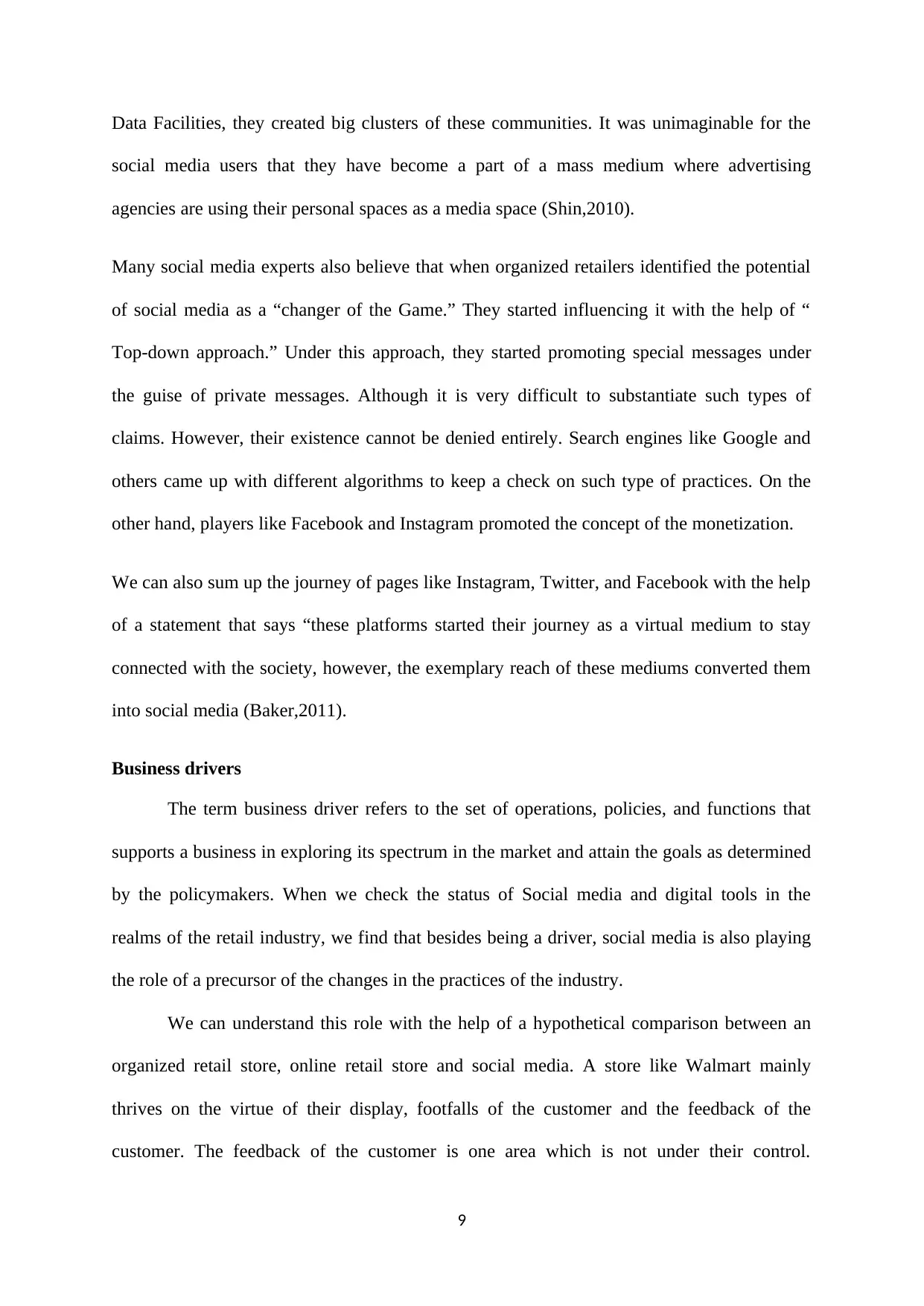
Data Facilities, they created big clusters of these communities. It was unimaginable for the
social media users that they have become a part of a mass medium where advertising
agencies are using their personal spaces as a media space (Shin,2010).
Many social media experts also believe that when organized retailers identified the potential
of social media as a “changer of the Game.” They started influencing it with the help of “
Top-down approach.” Under this approach, they started promoting special messages under
the guise of private messages. Although it is very difficult to substantiate such types of
claims. However, their existence cannot be denied entirely. Search engines like Google and
others came up with different algorithms to keep a check on such type of practices. On the
other hand, players like Facebook and Instagram promoted the concept of the monetization.
We can also sum up the journey of pages like Instagram, Twitter, and Facebook with the help
of a statement that says “these platforms started their journey as a virtual medium to stay
connected with the society, however, the exemplary reach of these mediums converted them
into social media (Baker,2011).
Business drivers
The term business driver refers to the set of operations, policies, and functions that
supports a business in exploring its spectrum in the market and attain the goals as determined
by the policymakers. When we check the status of Social media and digital tools in the
realms of the retail industry, we find that besides being a driver, social media is also playing
the role of a precursor of the changes in the practices of the industry.
We can understand this role with the help of a hypothetical comparison between an
organized retail store, online retail store and social media. A store like Walmart mainly
thrives on the virtue of their display, footfalls of the customer and the feedback of the
customer. The feedback of the customer is one area which is not under their control.
9
social media users that they have become a part of a mass medium where advertising
agencies are using their personal spaces as a media space (Shin,2010).
Many social media experts also believe that when organized retailers identified the potential
of social media as a “changer of the Game.” They started influencing it with the help of “
Top-down approach.” Under this approach, they started promoting special messages under
the guise of private messages. Although it is very difficult to substantiate such types of
claims. However, their existence cannot be denied entirely. Search engines like Google and
others came up with different algorithms to keep a check on such type of practices. On the
other hand, players like Facebook and Instagram promoted the concept of the monetization.
We can also sum up the journey of pages like Instagram, Twitter, and Facebook with the help
of a statement that says “these platforms started their journey as a virtual medium to stay
connected with the society, however, the exemplary reach of these mediums converted them
into social media (Baker,2011).
Business drivers
The term business driver refers to the set of operations, policies, and functions that
supports a business in exploring its spectrum in the market and attain the goals as determined
by the policymakers. When we check the status of Social media and digital tools in the
realms of the retail industry, we find that besides being a driver, social media is also playing
the role of a precursor of the changes in the practices of the industry.
We can understand this role with the help of a hypothetical comparison between an
organized retail store, online retail store and social media. A store like Walmart mainly
thrives on the virtue of their display, footfalls of the customer and the feedback of the
customer. The feedback of the customer is one area which is not under their control.
9
⊘ This is a preview!⊘
Do you want full access?
Subscribe today to unlock all pages.

Trusted by 1+ million students worldwide
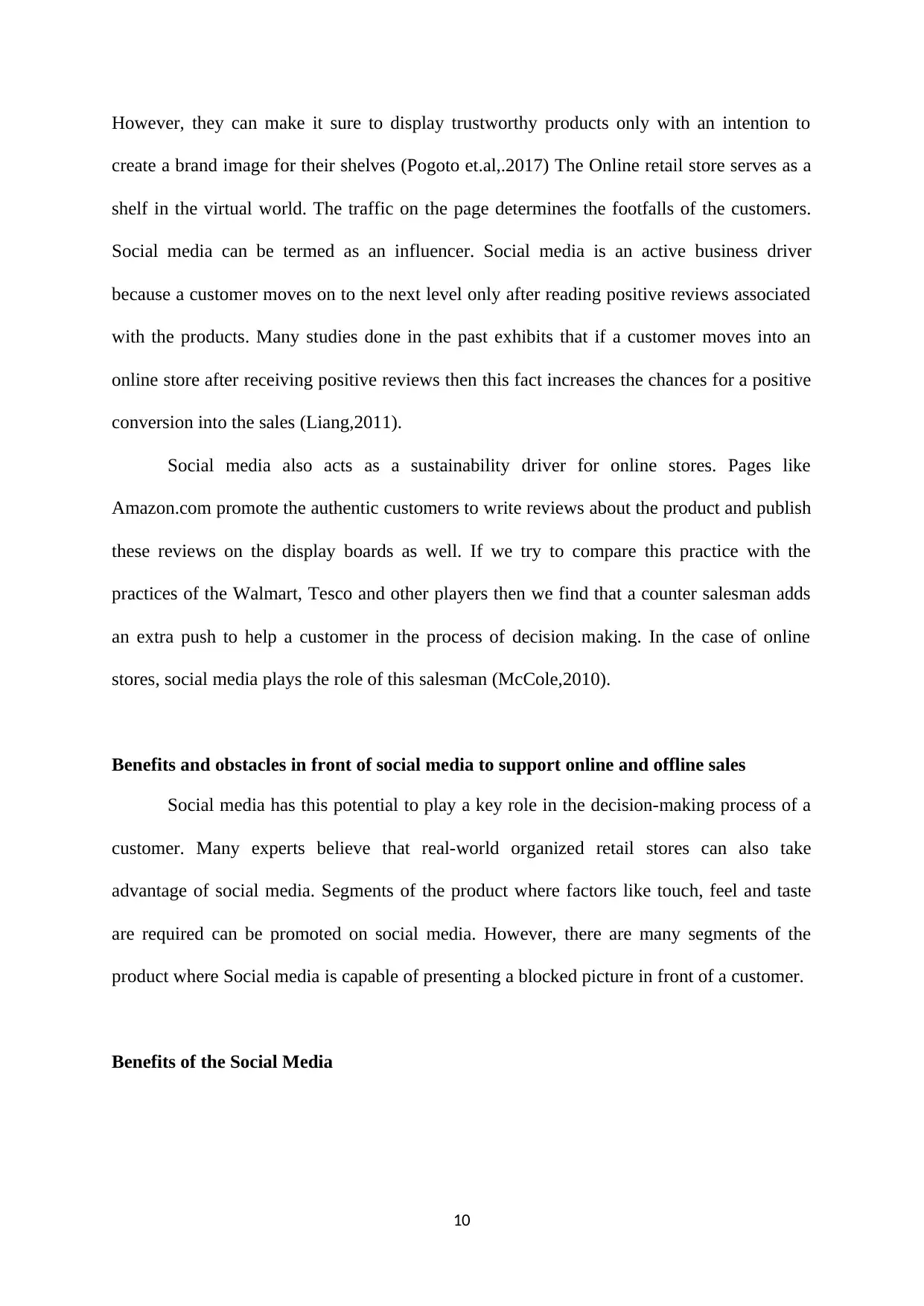
However, they can make it sure to display trustworthy products only with an intention to
create a brand image for their shelves (Pogoto et.al,.2017) The Online retail store serves as a
shelf in the virtual world. The traffic on the page determines the footfalls of the customers.
Social media can be termed as an influencer. Social media is an active business driver
because a customer moves on to the next level only after reading positive reviews associated
with the products. Many studies done in the past exhibits that if a customer moves into an
online store after receiving positive reviews then this fact increases the chances for a positive
conversion into the sales (Liang,2011).
Social media also acts as a sustainability driver for online stores. Pages like
Amazon.com promote the authentic customers to write reviews about the product and publish
these reviews on the display boards as well. If we try to compare this practice with the
practices of the Walmart, Tesco and other players then we find that a counter salesman adds
an extra push to help a customer in the process of decision making. In the case of online
stores, social media plays the role of this salesman (McCole,2010).
Benefits and obstacles in front of social media to support online and offline sales
Social media has this potential to play a key role in the decision-making process of a
customer. Many experts believe that real-world organized retail stores can also take
advantage of social media. Segments of the product where factors like touch, feel and taste
are required can be promoted on social media. However, there are many segments of the
product where Social media is capable of presenting a blocked picture in front of a customer.
Benefits of the Social Media
10
create a brand image for their shelves (Pogoto et.al,.2017) The Online retail store serves as a
shelf in the virtual world. The traffic on the page determines the footfalls of the customers.
Social media can be termed as an influencer. Social media is an active business driver
because a customer moves on to the next level only after reading positive reviews associated
with the products. Many studies done in the past exhibits that if a customer moves into an
online store after receiving positive reviews then this fact increases the chances for a positive
conversion into the sales (Liang,2011).
Social media also acts as a sustainability driver for online stores. Pages like
Amazon.com promote the authentic customers to write reviews about the product and publish
these reviews on the display boards as well. If we try to compare this practice with the
practices of the Walmart, Tesco and other players then we find that a counter salesman adds
an extra push to help a customer in the process of decision making. In the case of online
stores, social media plays the role of this salesman (McCole,2010).
Benefits and obstacles in front of social media to support online and offline sales
Social media has this potential to play a key role in the decision-making process of a
customer. Many experts believe that real-world organized retail stores can also take
advantage of social media. Segments of the product where factors like touch, feel and taste
are required can be promoted on social media. However, there are many segments of the
product where Social media is capable of presenting a blocked picture in front of a customer.
Benefits of the Social Media
10
Paraphrase This Document
Need a fresh take? Get an instant paraphrase of this document with our AI Paraphraser
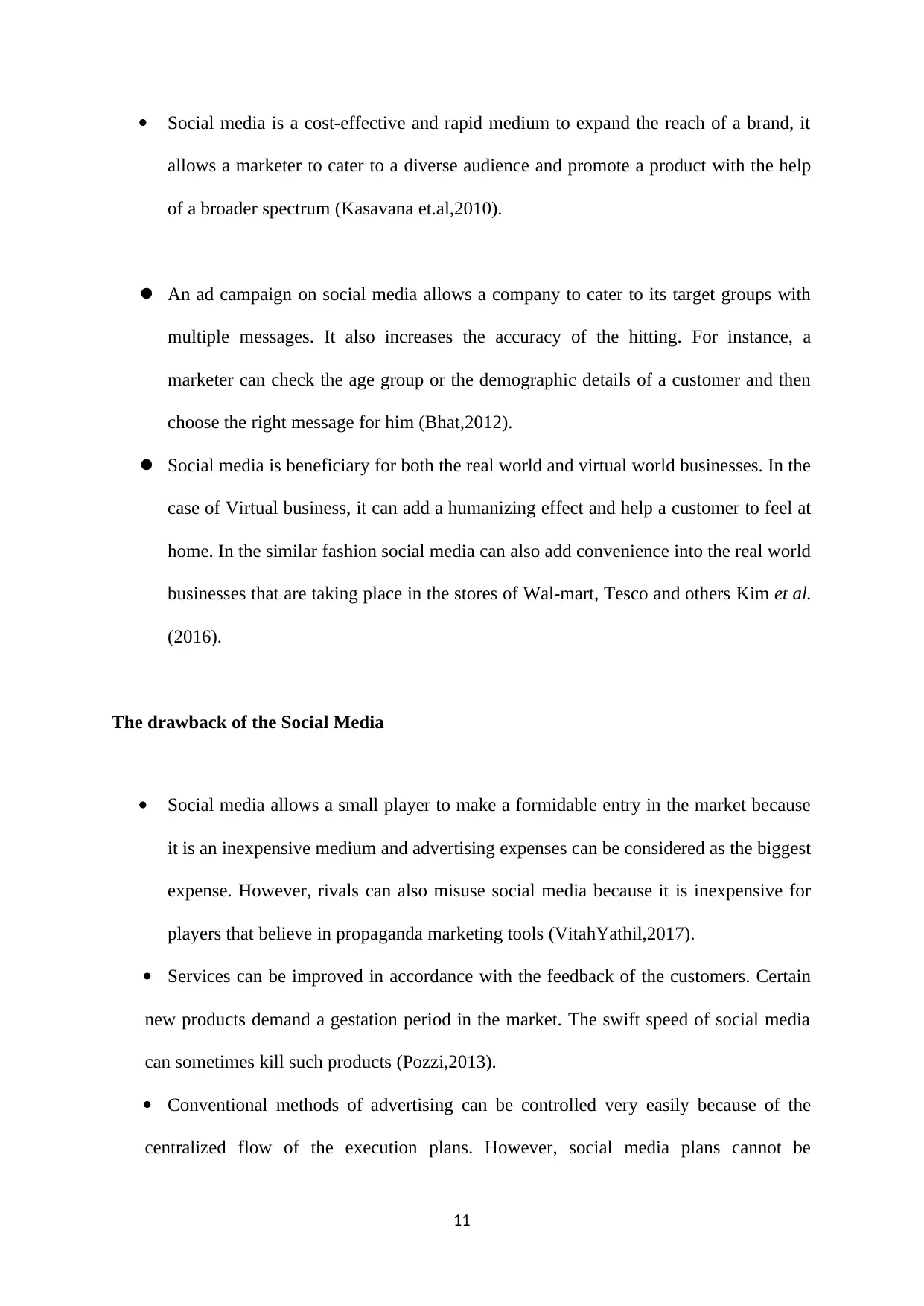
Social media is a cost-effective and rapid medium to expand the reach of a brand, it
allows a marketer to cater to a diverse audience and promote a product with the help
of a broader spectrum (Kasavana et.al,2010).
An ad campaign on social media allows a company to cater to its target groups with
multiple messages. It also increases the accuracy of the hitting. For instance, a
marketer can check the age group or the demographic details of a customer and then
choose the right message for him (Bhat,2012).
Social media is beneficiary for both the real world and virtual world businesses. In the
case of Virtual business, it can add a humanizing effect and help a customer to feel at
home. In the similar fashion social media can also add convenience into the real world
businesses that are taking place in the stores of Wal-mart, Tesco and others Kim et al.
(2016).
The drawback of the Social Media
Social media allows a small player to make a formidable entry in the market because
it is an inexpensive medium and advertising expenses can be considered as the biggest
expense. However, rivals can also misuse social media because it is inexpensive for
players that believe in propaganda marketing tools (VitahYathil,2017).
Services can be improved in accordance with the feedback of the customers. Certain
new products demand a gestation period in the market. The swift speed of social media
can sometimes kill such products (Pozzi,2013).
Conventional methods of advertising can be controlled very easily because of the
centralized flow of the execution plans. However, social media plans cannot be
11
allows a marketer to cater to a diverse audience and promote a product with the help
of a broader spectrum (Kasavana et.al,2010).
An ad campaign on social media allows a company to cater to its target groups with
multiple messages. It also increases the accuracy of the hitting. For instance, a
marketer can check the age group or the demographic details of a customer and then
choose the right message for him (Bhat,2012).
Social media is beneficiary for both the real world and virtual world businesses. In the
case of Virtual business, it can add a humanizing effect and help a customer to feel at
home. In the similar fashion social media can also add convenience into the real world
businesses that are taking place in the stores of Wal-mart, Tesco and others Kim et al.
(2016).
The drawback of the Social Media
Social media allows a small player to make a formidable entry in the market because
it is an inexpensive medium and advertising expenses can be considered as the biggest
expense. However, rivals can also misuse social media because it is inexpensive for
players that believe in propaganda marketing tools (VitahYathil,2017).
Services can be improved in accordance with the feedback of the customers. Certain
new products demand a gestation period in the market. The swift speed of social media
can sometimes kill such products (Pozzi,2013).
Conventional methods of advertising can be controlled very easily because of the
centralized flow of the execution plans. However, social media plans cannot be
11
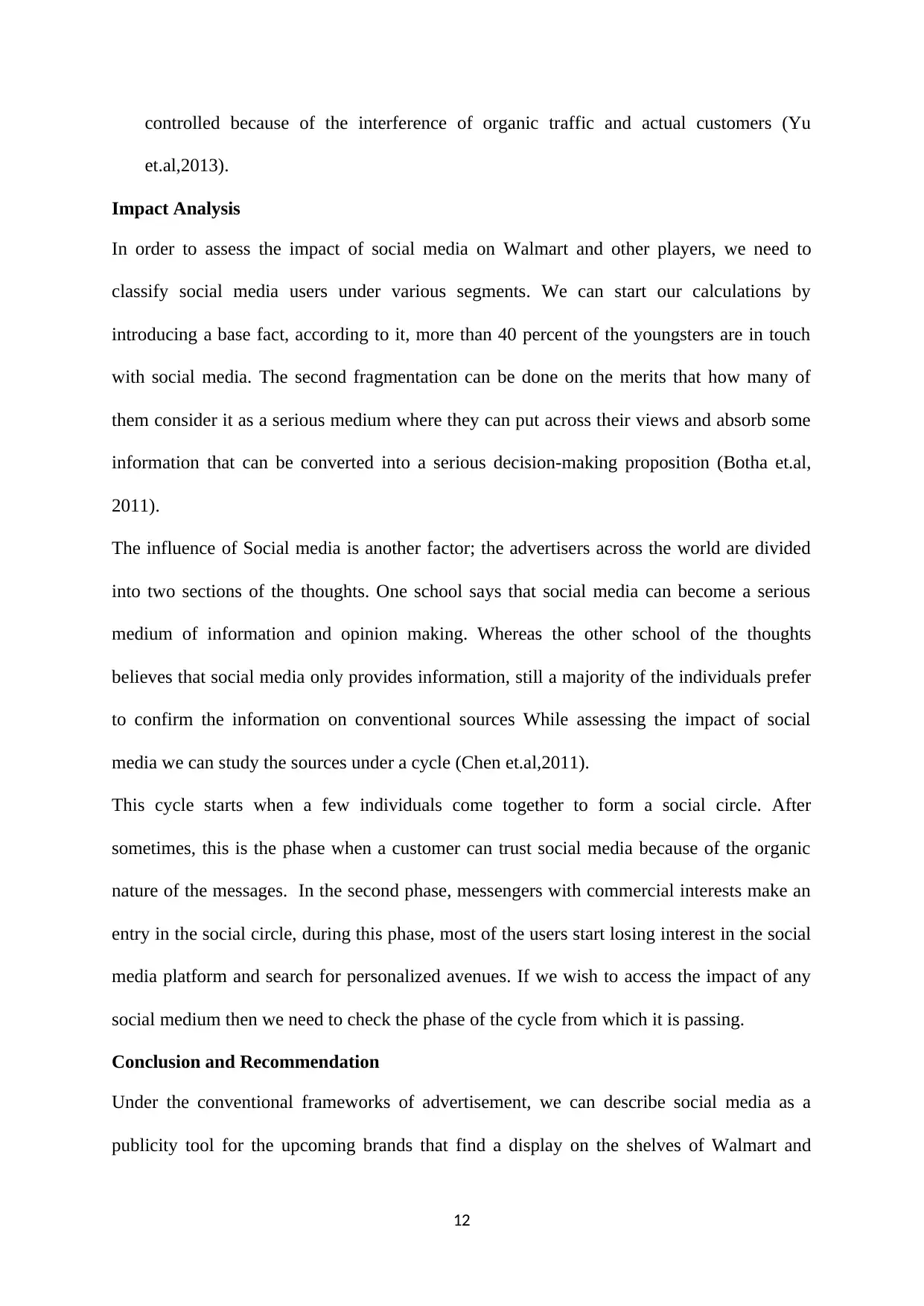
controlled because of the interference of organic traffic and actual customers (Yu
et.al,2013).
Impact Analysis
In order to assess the impact of social media on Walmart and other players, we need to
classify social media users under various segments. We can start our calculations by
introducing a base fact, according to it, more than 40 percent of the youngsters are in touch
with social media. The second fragmentation can be done on the merits that how many of
them consider it as a serious medium where they can put across their views and absorb some
information that can be converted into a serious decision-making proposition (Botha et.al,
2011).
The influence of Social media is another factor; the advertisers across the world are divided
into two sections of the thoughts. One school says that social media can become a serious
medium of information and opinion making. Whereas the other school of the thoughts
believes that social media only provides information, still a majority of the individuals prefer
to confirm the information on conventional sources While assessing the impact of social
media we can study the sources under a cycle (Chen et.al,2011).
This cycle starts when a few individuals come together to form a social circle. After
sometimes, this is the phase when a customer can trust social media because of the organic
nature of the messages. In the second phase, messengers with commercial interests make an
entry in the social circle, during this phase, most of the users start losing interest in the social
media platform and search for personalized avenues. If we wish to access the impact of any
social medium then we need to check the phase of the cycle from which it is passing.
Conclusion and Recommendation
Under the conventional frameworks of advertisement, we can describe social media as a
publicity tool for the upcoming brands that find a display on the shelves of Walmart and
12
et.al,2013).
Impact Analysis
In order to assess the impact of social media on Walmart and other players, we need to
classify social media users under various segments. We can start our calculations by
introducing a base fact, according to it, more than 40 percent of the youngsters are in touch
with social media. The second fragmentation can be done on the merits that how many of
them consider it as a serious medium where they can put across their views and absorb some
information that can be converted into a serious decision-making proposition (Botha et.al,
2011).
The influence of Social media is another factor; the advertisers across the world are divided
into two sections of the thoughts. One school says that social media can become a serious
medium of information and opinion making. Whereas the other school of the thoughts
believes that social media only provides information, still a majority of the individuals prefer
to confirm the information on conventional sources While assessing the impact of social
media we can study the sources under a cycle (Chen et.al,2011).
This cycle starts when a few individuals come together to form a social circle. After
sometimes, this is the phase when a customer can trust social media because of the organic
nature of the messages. In the second phase, messengers with commercial interests make an
entry in the social circle, during this phase, most of the users start losing interest in the social
media platform and search for personalized avenues. If we wish to access the impact of any
social medium then we need to check the phase of the cycle from which it is passing.
Conclusion and Recommendation
Under the conventional frameworks of advertisement, we can describe social media as a
publicity tool for the upcoming brands that find a display on the shelves of Walmart and
12
⊘ This is a preview!⊘
Do you want full access?
Subscribe today to unlock all pages.

Trusted by 1+ million students worldwide
1 out of 19
Related Documents
Your All-in-One AI-Powered Toolkit for Academic Success.
+13062052269
info@desklib.com
Available 24*7 on WhatsApp / Email
![[object Object]](/_next/static/media/star-bottom.7253800d.svg)
Unlock your academic potential
Copyright © 2020–2025 A2Z Services. All Rights Reserved. Developed and managed by ZUCOL.




